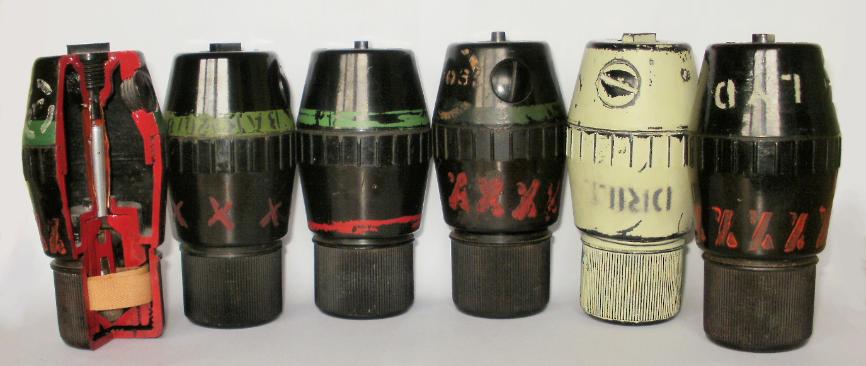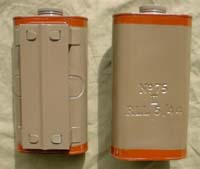EXPLOSIVES
Please note that all weapons shown here, and
those owned by members of this group are legally
deactivated,
held on approved fire arms licences, or are modern inert replicas.
Mills Bomb No.36M Mk1
William Mills, a hand grenade
designer from Sunderland, patented, developed and manufactured the
"Mills bomb" at the Mills Munition Factory in Birmingham, England, in 1915.
The Mills bomb underwent numerous
modifications and the No. 36M Mk. 1 was the British army's
standard hand-grenade from the 1930s to the
1970s.
The Mills was a classic design; a
grooved cast iron
"pineapple" with a central striker held
by a close hand lever and secured with a
pin.
According to Mills' notes the casing
was grooved to make it easier to grip
and not as an aid to fragmentation, and
in practice it has been demonstrated
that it does not shatter along the
segmented lines.
The Mills was a defensive grenade:
after throwing the user had to take
cover immediately. A competent thrower
could manage 15 yds with reasonable
accuracy, with a danger area of
about 100 yds.
At first the grenade was fitted with
a seven-second fuse, but during combat
in the Battle of France
in 1940 this delay proved to be too
long, giving defenders time to escape
the explosion, or even to throw the
grenade back, and was reduced to four
seconds.




No 69. Grenade
The
British No 69
was a hand grenade
developed and used during the Second World War. It was adopted into service due to the need
for a grenade with smaller destructive radius
than the No 36M "Mills bomb".
This allowed the thrower to use a grenade
even when there was little in the way of
defensive cover. In contrast, the much greater
destructive radius of the Mills bomb than its
throwing range forced users to choose their
throwing point carefully, in order to ensure
that they would not be wounded by their own
grenade.
The shell of the No 69 grenade was composed
entirely of the hard plastic, Bakelite, which shattered without producing
fragments like a metal bodied grenade.
The No 69 was the first British device to
make use of the 'all-ways fuse',
an impact-only fuse. The term "Allways"
refers to the fact that all of the
possible ways in which the grenade could
hit a target were guaranteed to trigger detonation.
The fuse was worked by the user first
unscrewing a plastic cap to expose a long,
narrow cloth streamer with a curved lead weight attached to the end. Upon release
from the hand or projector the weighted
streamer would catch the air and quickly
unwind from the top of the grenade,
eventually withdrawing a loose safety pin
from the fuse. With the pin removed the
striker and detonator would be free to
come into contact, which would happen due
to the force of impact when the grenade
struck a hard surface.
No. 75 Hawkins Mine
The
Grenade, Hand, Anti-tank, No. 75, also known as the Hawkins grenade
was a British
anti-tank
hand grenade. It was one of a number of grenades developed
for use by the British Army
and Home Guard
in the aftermath of the Dunkirk evacuation.
The grenade first appeared in 1942, and was
designed to be more versatile than previous
encarnates. When a vehicle drove over the grenade, it
cracked a chemical igniter and leaked acid
onto a sensitive chemical, which detonated
the explosive. Multiple grenades were often
used to destroy tanks or disable their
tracks, and the grenade could also be used
as a demolition charge. It was used by the
British Army and the United States Army



